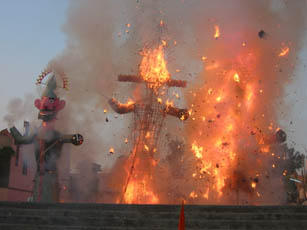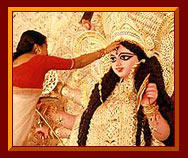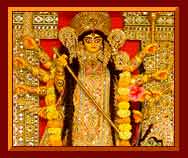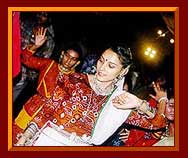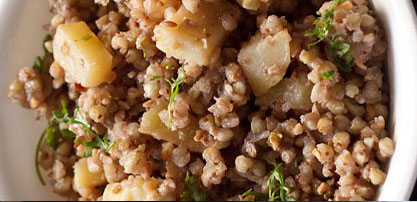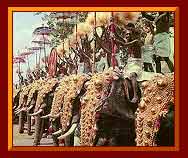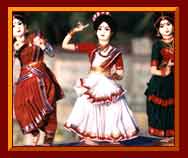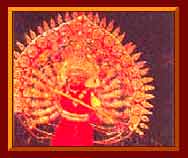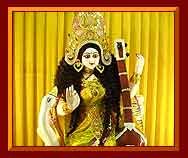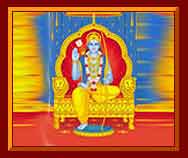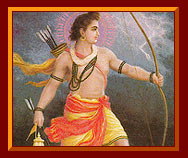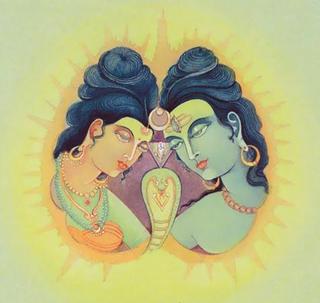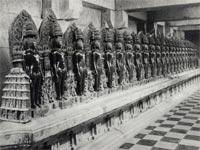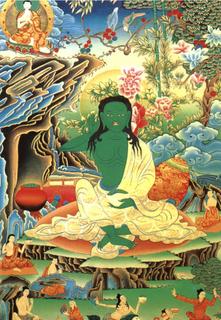Kali makes her 'official' debut in the Devi-Mahatmya, where she is said to have emanated from the brow of Goddess Durga (slayer of demons) during one of the battles between the divine and anti-divine forces. Etymologically Durga's name means "Beyond Reach". She is thus an echo of the woman warrior's fierce virginal autonomy. In this context Kali is considered the 'forceful' form of the great goddess Durga.
Kali is represented as a Black woman with four arms; in one hand she has a sword, in another the head of the demon she has slain, with the other two she is encouraging her worshippers. For earrings she has two dead bodies and wears a necklace of skulls ; her only clothing is a girdle made of dead men's hands, and her tongue protrudes from her mouth. Her eyes are red, and her face and breasts are besmeared with blood. She stands with one foot on the thigh, and another on the breast of her husband.
Kali's fierce appearances have been the subject of extensive descriptions in several earlier and modern works. Though her fierce form is filled with awe- inspiring symbols, their real meaning is not what it first appears- they have equivocal significance:
"Is Kali, my Divine Mother, of a black complexion? She appears black because She is viewed from a distance; but when intimately known She is no longer so.The sky appears blue at a distance, but look at it close by and you will find that it has no colour. The water of the ocean looks blue at a distance,but when you go near and take it in your hand, you find that it is colourless."
... Ramakrishna Paramhansa (1836-86)
Kali's nudity has a similar meaning. In many instances she is described as garbed in space or sky clad. In her absolute, primordial nakedness she is free from all covering of illusion. She is Nature (Prakriti in Sanskrit), stripped of 'clothes'. It symbolizes that she is completely beyond name and form, completely beyond the illusory effects of maya (false consciousness). Her nudity is said to represent totally illumined consciousness, unaffected by maya. Kali is the bright fire of truth, which cannot be hidden by the clothes of ignorance. Such truth simply burns them away.
She is full-breasted; her motherhood is a ceaseless creation. Her disheveled hair forms a curtain of illusion, the fabric of space - time which organizes matter out of the chaotic sea of quantum-foam. Her garland of fifty human heads, each representing one of the fifty letters of the Sanskrit alphabet, symbolizes the repository of knowledge and wisdom. She wears a girdle of severed human hands- hands that are the principal instruments of work and so signify the action of karma. Thus the binding effects of this karma have been overcome, severed, as it were, by devotion to Kali. She has blessed the devotee by cutting him free from the cycle of karma. Her white teeth are symbolic of purity (Sans. Sattva), and her lolling tongue which is red dramatically depicts the fact that she consumes all things and denotes the act of tasting or enjoying what society regards as forbidden, i.e. her indiscriminate enjoyment of all the world's "flavors".
Kali's four arms represent the complete circle of creation and destruction, which is contained within her. She represents the inherent creative and destructive rhythms of the cosmos. Her right hands, making the mudras of "fear not" and conferring boons, represent the creative aspect of Kali, while the left hands, holding a bloodied sword and a severed head represent her destructive aspect. The bloodied sword and severed head symbolize the destruction of ignorance and the dawning of knowledge. The sword is the sword of knowledge, that cuts the knots of ignorance and destroys false consciousness (the severed head). Kali opens the gates of freedom with this sword, having cut the eight bonds that bind human beings. Finally her three eyes represent the sun, moon, and fire, with which she is able to observe the three modes of time: past, present and future. This attribute is also the origin of the name Kali, which is the feminine form of 'Kala', the Sanskrit term for Time.
Another symbolic but controversial aspect of Kali is her proximity to the cremation ground:
O Kali, Thou art fond of cremation grounds; so I have turned my heart into oneThat thou, a resident of cremation grounds, may dance there unceasingly.O Mother! I have no other fond desire in my heart; fire of a funeral pyre is burning there; O Mother! I have preserved the ashes of dead bodies all aroundthat Thou may come. O Mother! Keeping Shiva, conqueror of Death, under Thy feet, Come, dancing to the tune of music; Prasada waits With his eyes closed
... Ramprasad (1718-75)
Kali's dwelling place, the cremation ground denotes a place where the five elements (Sanskrit: pancha mahabhuta) are dissolved. Kali dwells where dissolution takes place. In terms of devotion and worship, this denotes the dissolving of attachments, anger, lust, and other binding emotions, feelings, and ideas. The heart of the devotee is where this burning takes place, and it is in the heart that Kali dwells. The devotee makes her image in his heart and under her influence burns away all limitations and ignorance in the cremation fires. This inner cremation fire in the heart is the fire of knowledge, (Sanskrit: gyanagni), which Kali bestows.
The image of a recumbent Shiva lying under the feet of Kali represents Shiva as the passive potential of creation and Kali as his Shakti. The generic term Shakti denotes the Universal feminine creative principle and the energizing force behind all male divinity including Shiva. Shakti is known by the general name Devi, from the root 'div', meaning to shine. She is the Shining One, who is given different names in different places and in different appearances, as the symbol of the life-giving powers of the Universe. It is she that powers him. This Shakti is expressed as the i in Shiva's name. Without this i, Shiva becomes Shva, which in Sanskrit means a corpse. Thus suggesting that without his Shakti, Shiva is powerless or inert.
Kali is a particularly appropriate image for conveying the idea of the world as the play of the gods. The spontaneous, effortless, dizzying creativity of the divine reflex is conveyed in her wild appearance. Insofar as kali is identified with the phenomenal world, she presents a picture of that world that underlies its ephemeral and unpredictable nature. In her mad dancing, disheveled hair, and eerie howl there is made present the hint of a world reeling, careening out of control. The world is created and destroyed in Kali's wild dancing, and the truth of redemption lies in man's awareness that he is invited to take part in that dance, to yield to the frenzied beat of the Mother's dance of life and death.
O Kali, my Mother full of Bliss! Enchantress of the almighty Shiva!In Thy delirious joy Thou dancest, clapping Thy hands together!Thou art the Mover of all that move, and we are but Thy helpless toys
...Ramakrishna Paramhans
Kali and her attendants dance to rhythms pounded out by Shiva (Lord of destruction) and his animal-headed attendants who dwell in the Himalayas. Associated with chaos and uncontrollable destruction, Kali's own retinue brandishes swords and holds aloft skull cups from which they drink the blood that intoxicates them. Kali, like Shiva, has a third eye, but in all other respects the two are distinguished from one another. In contrast to Shiva's sweet expression, plump body, and ash white complexion, dark kali's emaciated limbs, angular gestures, and fierce grimace convey a wild intensity. Her loose hair, skull garland, and tiger wrap whip around her body as she stomps and claps to the rhythm of the dance.
Many stories describe Kali's dance with Shiva as one that "threatens to destroy the world" by its savage power. Art historian Stella Kramrisch has noted that the image of kali dancing with Shiva follows closely the myth of the demon Daruka. When Shiva asks his wife Parvati to destroy this demon, she enters Shiva's body and transforms herself from the poison that is stored in his throat. She emerges from Shiva as Kali, ferocious in appearance, and with the help of her flesh eating retinue attacks and defeats the demon. Kali however became so intoxicated by the blood lust of battle that her aroused fury and wild hunger threatened to destroy the whole world. She continued her ferocious rampage until Shiva manifested himself as an infant and lay crying in the midst of the corpse-strewn field. Kali, deceived by Shiva's power of illusion, became calm as she suckled the baby. When evening approached, Shiva performed the dance of creation (tandava) to please the goddess.
This terrific and poignant imagery starkly reveals the nature of Kali as the Divine Mother. Ramaprasad expresses his feelings thus:
Behold my Mother playing with Shiva, lost in an ecstasy of joy!Drunk with a draught of celestial wine, She reels, and yet does not fall. Erect She stands on Shiva's bosom, and the earth Trembles under Her tread; She and Her Lord are mad with frenzy, casting Aside all fear and shame.
... Ramprasad (1718-75)
Kali's human and maternal qualities continue to define the goddess for most of her devotees to this day. In human relationships, the love between mother and child is usually considered the purest and strongest. In the same way, the love between the Mother Goddess and her human children is considered the closest and tenderest relationship with divinity. Accordingly, Kali's devotees form a particularly intimate and loving bond with her. But the devotee never forgets Kali's demonic, frightening aspects. He does not distort Kali's nature and the truths she reveals; he does not refuse to meditate on her terrifying features. He mentions these repeatedly in his songs but is never put off or repelled by them. Kali may be frightening, the mad, forgetful mistress of a world spinning out of control, but she is, after all, the Mother of all.
O Kali! Why dost Thou roam about nude? Art Thou not ashamed, Mother! Garb and ornaments Thou hast none; yet Thou Pridest in being King's daughter. O Mother! Is it a virtue of Thy family that Thou Placest thy feet on Thy husband? Thou art nude; Thy husband is nude; you both roam cremation grounds. O Mother! We are all ashamed of you; do put on thy garb. Thou hast cast away Thy necklace of jewels, Mother, And worn a garland of human heads.Prasada says, "Mother! Thy fierce beauty has frightenedThy nude consort.
... Ramaprasad
The soul that worships becomes always a little child: the soul that becomes a child finds God oftenest as mother.
Kali's boon is won when man confronts or accepts her and the realities she dramatically conveys to him. The image of Kali, in a variety of ways, teaches man that pain, sorrow, decay, death, and destruction are not to be overcome or conquered by denying them or explaining them away. Pain and sorrow are woven into the texture of man's life so thoroughly that to deny them is ultimately futile. For man to realize the fullness of his being, for man to exploit his potential as a human being, he must finally accept this dimension of existence. Kali's boon is freedom, the freedom of the child to revel in the moment, and it is won only after confrontation or acceptance of death. To ignore death, to pretend that one is physically immortal, to pretend that one's ego is the center of things, is to provoke Kali's mocking laughter. To confront or accept death, on the contrary, is to realize a mode of being that can delight and revel in the play of the gods. To accept one's mortality is to be able to let go, to be able to sing, dance, and shout.
"The Primordial Power is ever at play.She is creating, preserving, and destroying in play, as it were. This Power is called kAli. kAli is verily Brahman,and Brahman is verily kAli. It is one and the same Reality."
"Oh, She plays in different ways. It is She alone who is known as MahA-kAli, Nitya-kAli, ShmashAna-kAli, RakshA-kAli, and ShyAmA-kAli. ShyAmA-kAli has a somewhat tender aspectand is worshipped in the Hindu households.She is the Dispenser of boons and the Dispeller of fear.People worship RakshA-kAli, the Protectress, in times of epidemic, famine, earthquake, drought and flood. ShmashAna-kAli is the embodiment of the power of destruction."
"The Divine Mother wants to continue playing with Her created beings. In a game of hide-and-seek the running about soon stops if in the beginning all the players touch the 'granny'. If all touch her, than how can the game go on? That displeases Her. Her pleasure is in continuing the game."
"It is as if the Divine Mother said to the human mindin confidence, with a sign from Her eye,'Go and enjoy the world'. How can one blame the mind? The mind can disentangle itself from worldliness if, through Her grace, She makes it turn toward Herself.Only then does it become devoted to the Lotus Feet of the Divine Mother."
"The jnAnis, who adhere to the non-dualistic philosophy of VedAnta, say that the acts of creation, preservation and destruction, the universe itself and all its living beings,are the manifestation of Shakti, the Divine Power.If you reason it out, you will realize that all these are as illusory as a dream. Brahman alone is the Reality, and all else is unreal. Even this very Shakti is unsubstantial, like a dream."
"Not a leaf moves except by the will of God. Where is man's free will? All are under the will of God. Therefore I say: 'O Mother, I am the machine and Thou art the Operator; I am the chariot and Thou art the Driver.I move as Thou movest me; I do as Thou makest me do'."
"Is it possible to understand God's action and His motive?He creates, He preserves, and He destroys. Can we ever understand why He destroys?I say to the Divine Mother: 'O Mother,I do not need to understand. Please give me love for Thy Lotus Feet'.The aim of human life is to attain bhakti. As for other things, the Mother knows best."
"Is kAli, my Divine Mother, of a black complexion? She appears black because She is viewed from a distance; but when intimately known She is no longer so. The sky appears blue at a distance, but look at it close by and you will find that it has no colour. The water of the ocean looks blue at a distance, but when you go near and take it in your hand, you find that it is colourless."
"Though you reason all your life, unless you are established in SamAdhi, you cannot go beyond the jurisdiction of Shakti. Even when you say, 'I am meditating', or 'I am contemplating', still you are moving in the realm of Shakti, within It's power."
"One must propitiate the Divine Mother, the Primal Energy,in order to obtain God's grace. God Himself is MahAmAyA, who deludes the world with Her illusion and conjures up the magic of creation, preservation and destruction."
"The Divine Mother is always playful and sportive. This universe is Her play. She is self-willed and must always have Her own way. She is full of bliss. She gives freedom to one out of a hundred thousand."
"The worship of Shakti is extremely difficult. It is no joke.I passed two years as the handmaid of the Divine Mother. But my natural attitude has always been that of a child toward its mother. I regard the breasts of any woman as those of my own mother."
"He who is attributeless also has attributes.He who is Brahman is also Shakti. When thought of as inactive,He is called Brahman, and when thought of as Creator, Preserver, and Destroyer, He is called the Primordial Energy, kAli."
"Brahman and Shakti are identical, like fire and its power to burn.When we talk of fire we automatically mean also its power to burn. Again, the fire's power to burn implies the fire itself. If you accept the one you must accept the other."
"In my present state of mind [Oct.24, 1882] I can eat a little fish soup if it has been offered to the Divine Mother beforehand. I can't eat any meat, even if it is offered to the Divine Mother; but I taste it with the end of my finger lest She should be angry."
"Once a man realizes God through intense dispassion,he is no longer attached to woman.Even if he must lead the life of a householder,he is free from fear of and attachment to woman.Suppose there are two magnets, one bigand the other small.Which one will attract the iron? The big one,of course. God is the big magnet. Compared to Him,woman is a small one. He who has realized God does not look upona woman with the eye of lust;so he is not afraid of her.He perceives clearly that women are but so many aspectsof the Divine Mother.He worships them all as the Mother Herself."
In response to a question from Mahima about'something holding us back' from spiritual progress"Why? Cut the reins. Cut them with the swordof God's name. 'The shackles of kAla,time, are cut by kAli's name.'"
"God is engaged in three kinds of activity: creation, preservation and destruction.Death is inevitable. All will be destroyed at the time of dissolution. Nothing will remain. At that time the Divine Motherwill gather up the seeds for the future creation,even as the elderly mistress of the house keeps in her hotchpotch-pot little bags of cucumber seeds,'sea-foam', blue pills, and other miscellaneous things. The Divine Mother will take her seeds out again at the time of the new creation."
"You know I am a fool. I know nothing.Then who is it that says all these things? I say to the Divine Mother: 'O Mother, I am the machine and Thou art the Operator.I am the house and Thou art the indweller. I am the chariot and Thou art the Charioteer.I do as Thou makest me do. I speak as Thou makest me speak; I move as Thou makest me move. It is not I ! It is all Thou ! It is all Thou !'Hers is the glory; we are only Her instruments."





